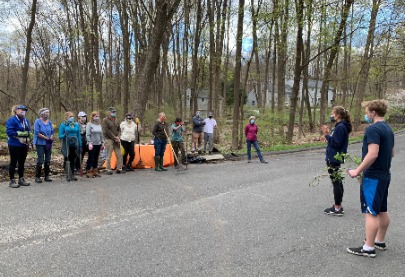My First Day with the WLCT
~ By Julia Elmasry
August 29, 2021

April 20, 2021
By Julia Elmasry | 2021 WLCT Spring Intern
On April 18th, 2021, I attended my first event (Stewardship Sunday) with the Wilton Land Conservation Trust as the Spring Intern. I was nervous, as I am with anything having to do with public speaking. I had only recently met with David McCarthy, Executive Director, and Eli Grass, Field Ranger and Open Space Steward, and was still getting used to the swing of things.
That day, I was the first to arrive, ready with my anti-tick spray and little background knowledge of invasive species. Once Eli and David arrived, we walked the site to prep for the event, identifying the work to be done and the invasive species to remove. Then, we set up with all of our tools and prepared to take on the Comstock Hill Cemetery. To start the community workday, Eli and I led an invasive species workshop to teach the volunteers about the two most common invasive species found on this site: Boys Scouts, WLCT Trustees, community members, and members of DAR (Daughters of the American Revolution).
The first was Japanese Barberry. Barberry was first in Japan and Asia before coming to the United States. It is a prickly plant that people buy and plant in the springtime because of its vibrant berries that grow. Little do those that buy this plant know that it grows like wildfire and becomes tick central. The birds love the berries and use them as one of their primary food sources in the spring. With so many birds eating them, the seeds spread throughout the forests, causing Barberry bushes to grow in unwanted areas.
Additionally, the bush is very thick with thorns. Because of this, animals will rub up against it, and rodents will hide from predators underneath it. As a result, ticks will cling onto this bush. The mere presence of Barberry will significantly increase the chances of ticks biting people and pets: spreading Lyme disease.
The second invasive plant we identified was Euonymus (burning bush): native to Northeastern Asia. In the United States, it decimates forests by spreading quickly, leeching nutrients and moisture from the soil, which prohibits other plants (natives) from growing underneath it. This invasive plant took over the site, so we needed to cut it down. Many don’t realize that it can take six to seven years to completely wipe it out, including digging it up from the ground and applying herbicides. So, please think twice before planting it in your backyard!
As the workday progressed, I met many interesting people from both the DAR and the Boy Scouts. This event was important to the DAR because this cemetery was a sacred place to honor the lives lost in the American Revolution. Being able to help clean out this area by raking, cutting down invasives, pulling weeds, and leveling out the walking path brought us to a rewarding end goal that we all worked together to achieve. I learned a great deal of helpful information in just the four short hours that I was there. I cannot wait to be a part of the next Stewardship Sunday, and I look forward to meeting more people soon!